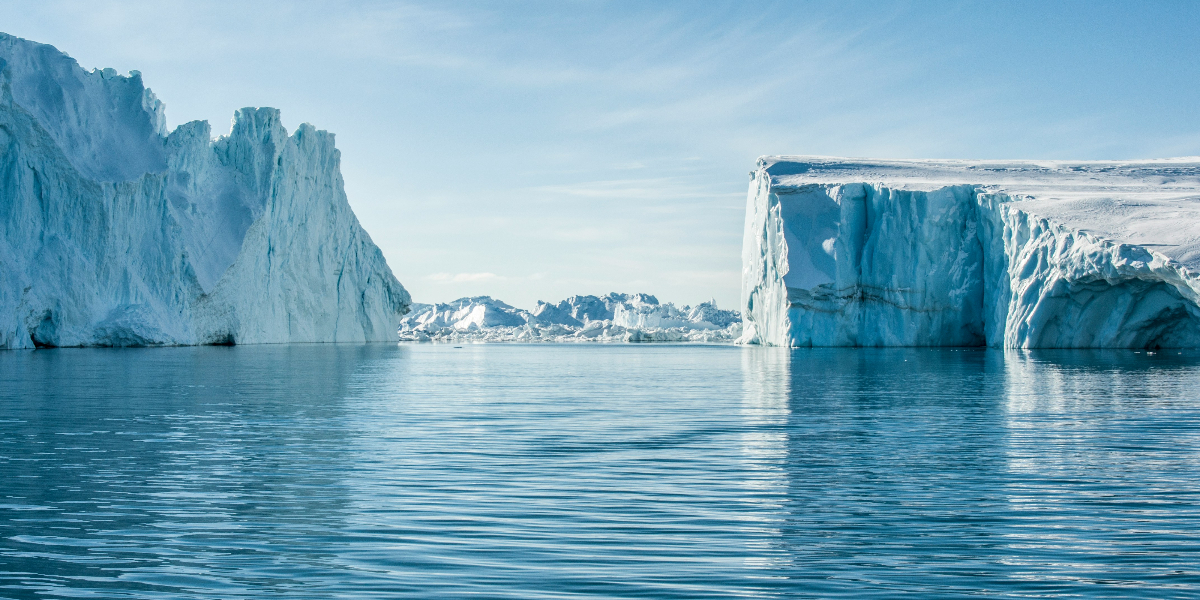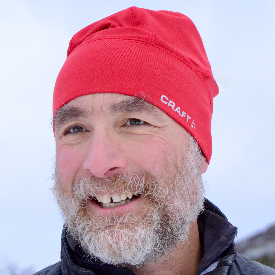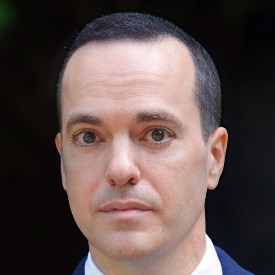Paul Bierman is a geologist by training, who teaches environmental science at the University of Vermont. There, he develops methods for understanding ice and dating rocks. His writing has been published in Science and Nature, and his findings have been covered by CNN, The New York Times, Washington Post, and the Weather Channel.
Below, Paul shares five key insights from his new book, When the Ice Is Gone: What a Greenland Ice Core Reveals About Earth’s Tumultuous History and Perilous Future. Listen to the audio version—read by Paul himself—in the Next Big Idea App.

1. It’s amazing what people can accomplish.
On the surface, When the Ice is Gone is about Greenland: a stunningly beautiful and remote place where people have done some crazy things. Whether it was explorers crossing the ice sheet on foot more than a century ago while pulling 200-pound sledges or three men living under the ice through the winter of 1931 in a snow cave they dug by hand, the island has always attracted people who live on the edge.
It has also spawned unordinary ideas and driven people to accomplishments that sound like fantasy or science fiction, like building a military base inside an ice sheet. That base, Camp Century, was a Cold War reality built both out of fear (would the Red Army or its missiles come across the top of the world to get us?) and a desire to conquer the unknown.
Carving into the Greenland Ice Sheet to construct Camp Century began in 1959. First, trenches 30 to 40 feet deep were cut by massive snowplows—the kind used to clear snow from passes in the Alps. Then, metal arches spanned the trenches, and after a thick layer of snow covered the arches, the metal was removed. Voila! A 1,000-foot-long main street appeared inside the ice sheet, with a dozen lanes branching off to the sides.
The camp, nearly invisible from the air, was 138 miles from the coast. It sat at 7,000 feet elevation, well above the Arctic Circle. There, 200 men lived in prefabricated bunk houses fit snugly into the snow tunnels and heated to a balmy 70 degrees. There were flush toilets and unlimited showers. The mess hall baked bread and roasted chicken. All of this was powered by the world’s first portable nuclear reactor: built in New York, shipped to Greenland, hauled across the ice, and assembled in place. It generated power for over two years, a stunning accomplishment that allowed the camp to run year-round.
Camp Century’s most stunning accomplishment was scientific. It took six years, but in the summer of 1966, just before the Army abandoned the undersnow camp, a small group of scientists did something that had never been done. They drilled through an ice sheet. After recovering an ice core nearly a mile long, they kept drilling and retrieved over 11 feet of frozen soil. It’s amazing what people can do when they set their minds to it.
2. It takes a vision and a visionary to do things that matter.
It took a village, or rather an army, to make Camp Century happen but one man’s vision catalyzed the science. That was Henri Bader, a Swiss geologist who had trained with the best to study minerals and their characteristic crystals.
When he needed a job after graduate school, studying snow and avalanches wasn’t such a big leap. Snow is, after all, crystalline water. But with World War II fast approaching, Bader escaped Switzerland for Argentina in the summer of 1938. Just a month later, he married Adele, a Swiss woman. They spent the war in South America and the Caribbean and remained together for the rest of their lives until they died in their 90s.
A few weeks after Victory in Europe Day, the couple flew to the United States, where Bader took a professorship at Rutgers. He quickly caught the attention of the U.S. Army. Within a few years, they sent Bader back to Europe to assess the state of glacier science. By 1949, Bader was studying glacial ice in Alaska. In 1950, he was part of the first U.S. ice coring expedition, supported by military planes that landed and took off from the Taku glacier near Juneau. Vintage home movies show the planes, the ice core, and Bader in a bulky overcoat as the glacier melts beneath his feet and the drill rig spins.
“Bader had the vision to know that ice sheets held a history of how climate changed over thousands of years.”
For the next 15 years, Bader’s was the American face of snow, ice, and ice sheets. He spent summers in Greenland and winters inside walk-in freezers outside of Chicago, testing snow and ice in his cold lab. He and the Army collected more ice cores in 1957 and 1958, the deepest from Greenland then. He wrote manifestos describing how to analyze an ice core and what the results could tell careful scientists.
Bader viewed glaciers as an archive, an icy library. He knew they held secrets in a language that people could translate with the right analyses and instruments. The ice could tell stories of the past, like when volcanoes erupted, when people began smelting silver ore, and when drivers began using leaded gasoline in their cars. But most importantly, Bader had the vision to know that ice sheets held a history of how climate changed over thousands of years.
Bader tailored his science for applications that mattered to the Army. In the 1950s, the climate appeared to be warming. The Army cared deeply about such warmth because it was difficult to maneuver in cold places when they warmed and melted. Bader and his team of scientists and engineers had the resources to drill and retrieve that unique ice core from deep below Camp Century. Getting a nearly mile-long ice core in the 1960s took a vision and a visionary team.
3. There are limits.
Camp Century pushed both people and the ice to its limits. But you wouldn’t know it from the relentless positive press coverage. Glossy photos of the Camp graced major magazines: the Saturday Evening Post, National Geographic, Popular Science, and even Boy’s Life. Walter Cronkite and CBS News paid a visit and aired a half-hour TV special about the camp.
But the veneer of happy news belied the life of an enlisted man at the camp. Some loved their time on the ice. Many were miserable. Three different men walked out onto the snow and headed for the coast. They didn’t get far before they were dragged back to the base hospital and sent home. Another man made a chain of paperclips, one for each day of his tour of duty. A book by Lee David Hamilton, Century: Secret City of the Snow, tells the story: “Every morning when he arrived at work, off came a paper clip from the great chain. In this manner, he kept track of the days and the months until, as he said, ‘The time of this white hell has ended for me.’”
The ice sheet was not the camp’s friend. No sooner was Camp Century completed than the walls began closing in. Ice and snow might appear strong, but both flow over time. The warmer they get, the faster they flow. At Camp Century, most trenches closed about a foot each year. Those housing the mess hall and nuclear reactor were warmer and closed several feet a year, threatening the men’s food and power. Year-round, the Army dispatched chainsaw-wielding teams to cut away the encroaching walls before they smashed the buildings. Even the most visionary among us have limits imposed by nature.
4. Ice is fragile stuff.
Ice has a habit of melting. After decades of talking about climate change, we are conditioned to photographs of polar bears stranded on slabs of melting sea ice or mountain glaciers shrunk to mere shadows of their former selves. But ice sheets are massive and robust. How could they ever melt?
A Danish physicist, Willi Dansgaard, analyzed thousands of samples from the nearly mile of ice recovered at Camp Century. In 1969, he published a paper that changed how scientists thought of climate change. The ice provided a stunning record of tens of thousands of years of glacial cold and then, a bit more than 100,000 years ago, a time of warmth, not unlike today. But the ice didn’t melt away at Century; only its composition changed.
“We looked in amazement at the top and bottom of the frozen soil core, full of brown sandy material collected in 1966 from below the ice sheet.”
Soon, there were other ice cores acquired from Greenland, and Camp Century’s core was of less and less interest. In the mid-1990s, the lower part of the core, including the frozen soil, vanished. Most scientists gave it up for lost until, in 2019, the Danes found the pieces of ice and soil safely nested in old cardboard boxes as they moved their collection to a new freezer. A few months later, they sent two samples to my lab. We looked in amazement at the top and bottom of the frozen soil core, full of brown sandy material collected in 1966 from below the ice sheet.
On a steamy July day, we melted the samples and began washing them, sorting the grains by size: gravel here, sand there, etc. I stared into a bin of sand as it settled through the water and noticed odd, black bits of material floating on the surface. One looked like a small twig; another might have been a piece of a leaf. I sucked them up with a pipette, placed them gently on a small plastic tray, and handed it to my colleague. He examined the tray under the microscope and after a moment of silence, looked up and let out a loud, “Holy shit!”
That afternoon, we found plant fossils in the frozen soil. They could only mean that there was a time when Camp Century had no ice, and instead, plants covered the landscape. The ice melted away from Camp Century at least once before. It could melt again.
5. Greenland has arms that wrap around the planet.
Greenland is a faraway place. It’s not easy to get there, and once you do, there aren’t many people. But don’t let that fool you. Greenland has long arms that wrap around the planet.
When Greenland’s ice melts, water that was once frozen solid on land flows into the ocean, raising the planet’s sea level—like filling a bathtub. When Greenland’s ice is all gone, the global ocean will be 26 feet higher. The great coastal megacities of Asia (Jakarta, Kolkata, Osaka, Tokyo, Hanoi, and Shanghai) will all be underwater. Several hundred million people will become climate refugees if Greenland’s ice sheet completely melts.
After finding the fossil plants, we set about dating the frozen soil. Analyzing small mineral crystals, we learned that they, and thus the plants, were last exposed to sunlight about 400,000 years ago. That’s a time when the Earth was about as warm as it is today, but the sea level was 20 to 40 feet higher. At least some, and perhaps most, of Greenland’s ice had melted in the past without human interference.
It’s sobering to realize that 400,000 years ago, there were about 280 parts per million of planet-warming carbon dioxide in the atmosphere. Today, there are 420 parts per million, and the level is climbing quickly—50 percent more than when Greenland’s ice melted in the past. It’s not hard to predict the future. Unless we reduce the concentration of greenhouse gasses in the atmosphere and stop the warming, much or all of Greenland’s ice is doomed.
It’s amazing what people with a vision can accomplish. Fixing what we have done to the planet will not be easy. Neither was living in an ice sheet and drilling the first ice core. It’s time we get started.
To listen to the audio version read by author Paul Bierman, download the Next Big Idea App today:
































